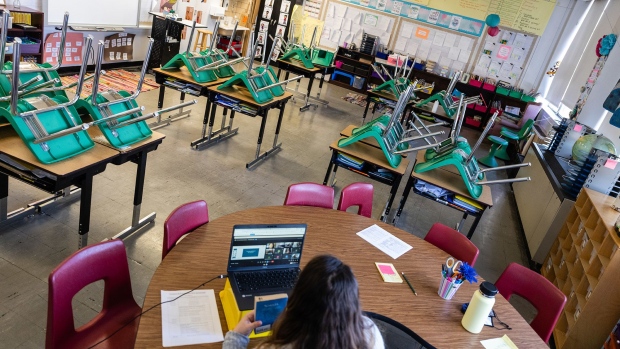Jan 15, 2022
Parents and Retirees Teach Class as Omicron Sidelines Faculty
, Bloomberg News

(Bloomberg) -- Clark County, Nevada, was short nearly 2,000 teachers this week.
The district had 400 substitutes to cover them.
That simple math problem forced central-office staff into classrooms, students into auditoriums, and eventually led one of the largest districts in the U.S. to halt instruction.
“It was putting a real strain on the operations of the school district,” said Superintendent Jesus Jara, who spoke with White House officials on Wednesday about securing personal protective equipment and implementing a test-to-stay program.
Across the country, schools are in a mad dash for substitutes and staff, thanks to Covid-19 cases that have broken records every day since the beginning of the year, according to the U.S. Centers for Disease Control and Prevention.
Connecticut Governor Ned Lamont this month signed an order giving retired teachers flexibility to work without losing benefits; a similar move awaits New Jersey Governor Phil Murphy’s signature. North Carolina’s governor gave state employees permission to use paid volunteer days to work in schools, while districts in Texas have asked parents to step in.
In New York, which Governor Kathy Hochul estimates will need 180,000 new teachers over the next decade, the state is waiving income limits for retired teachers and reducing a lengthy certification process for new ones.
The Austin, Texas, district announced a pay increase for substitutes Friday, boosting top rates to as high as $225 a day. With about 500 requests for substitutes each day this week, officials are appealing to parents, retired teachers, people considering a career in education or just about anyone else who is willing to go through a background check and wrangle a classroom full of kids.
“We really want to be aggressive,” said Eduardo Villa, a spokesman. “Everyone right now is looking, so we want to recruit the best and be competitive.”
Headquarters employees are stepping in, and Villa spent a day this week overseeing a classroom of second-graders. He led them through a science lesson about rocks, which included taking the 7- and 8-year-olds outside to collect specimens, then noting their texture, color and form.
“I was so nervous at the beginning of the day,” Villa said. But it went well. “My group was very fun to be around.”
Federal stimulus funding is helping some schools. About 12% of 2,400 schools analyzed planned to spend American Rescue Plan funds on bonuses, hazard pay or overtime, according to Burbio, a company that provides school data. Still, many plans were drafted before the recent case surge. On Thursday, Clark County’s board approved a $2,000 retention bonus for staff, funded by federal dollars, Jara said.
Chicago Public Schools, which has been embroiled in a clash with the teachers’ union over virus safety, has tapped federal funds to recruit substitutes and is shifting schedules to plug staffing holes. The district introduced incentives, like a $45-per-day bonus for substitutes in hard-to-fill schools.
Officials in rural districts have had to get creative. The Hays Consolidated Independent School District, southwest of Austin, Texas, put out a plea on social media for parents to work as guest teachers. Officials waived a rule requiring subs have 30 college credit hours, so long as they have a referral from the principal.
Near Dallas, the Plano Independent School District was short 190 substitutes one day last week, so understaffed that the superintendent Sara Bonser covered a fourth-grade class. “We were all hands on deck,” Bonser said at a school board meeting.
Staffing Pressure
Tom Roberson, 70, volunteers at the Leonardo Da Vinci School in Sacramento, California, attended by his fifth- and eighth-grade sons. His unpaid help has become more important than ever.
Around 9 a.m., Roberson sets up tables and chairs outdoors for lunch, and he comes back around midday to monitor the kids as they eat in shifts. While it’s not always easy to help the groups of gregarious children keep their distance, Roberson said it’s worth taking on a little risk.
“Online schooling is effective, but only to a degree -- there’s just this huge gap when kids can’t see each other, or aren’t getting the in-class projects and support,” he said Friday.
Education officials and advocates say the extreme shortages result from a long-term dearth of teachers in the U.S., driven by a weak recruiting pipeline and years of sub-par pay. The so-called teacher wage penalty, which measures the gap between teachers and similarly educated professionals, has grown since the mid-1990s, according to a study by the Economic Policy Institute.
“You start to see more desperation in hiring, and that tends to fall inequitably,” said Bruce Baker, a professor in the graduate school of education at Rutgers University in New Jersey.
For teachers, sustained labor shortages mean daunting workloads. Will Johnson, a high-school English and special education teacher in Brooklyn, estimated about 10% to 20% of his department has been sick on any given day since winter break. He rarely sees substitutes, and sacrifices his planning periods to cover for colleagues.
“I’ve never seen anything like this level of teacher absences,” Johnson said. “It creates all this extra labor for people who are already overworked.”
©2022 Bloomberg L.P.







